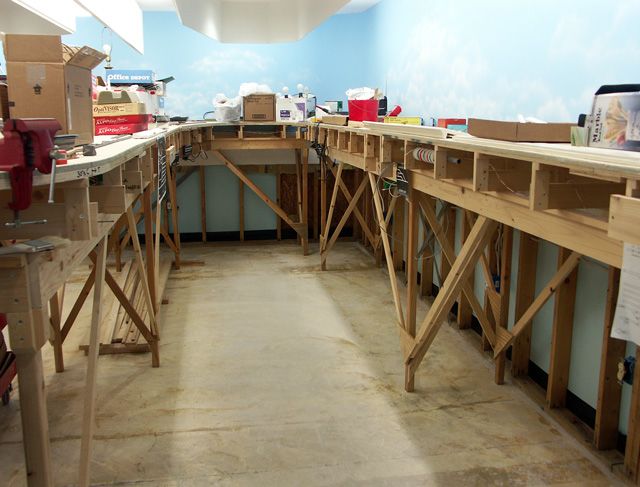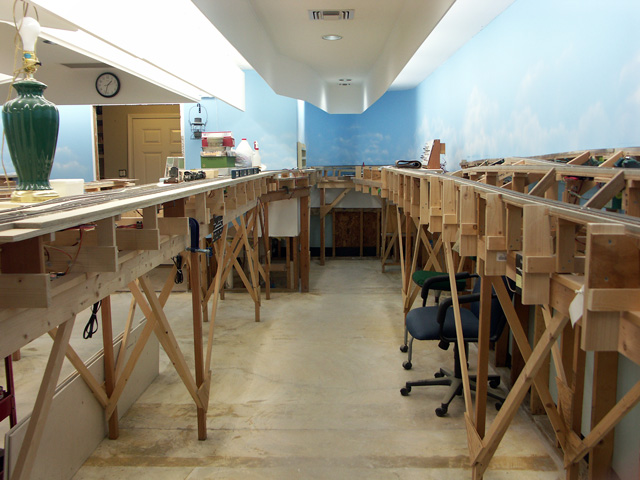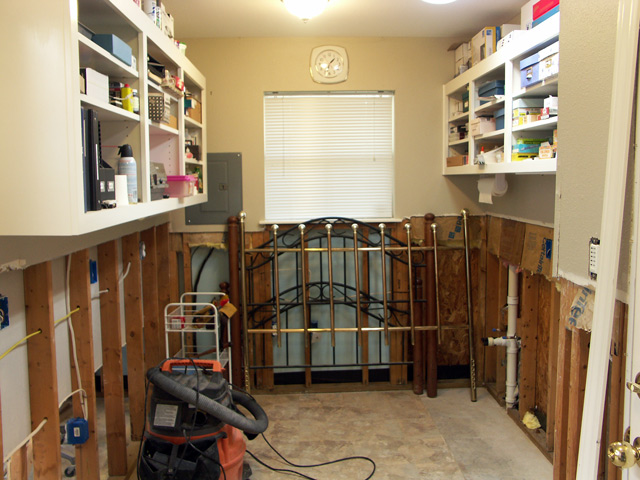It seems like forever since the flooding of my home and train room last August. While both buildings have been dried out, cleaned and treated for mold, and prepped for construction, not much has happened in the reconstruction department. The problem has primarily been procuring the services of a reliable, local contractor. But the search has ended, and I should be starting that reconstruction process within a few weeks. I’ve started the ball rolling by insulating the house. I’ve nearly through with the living area, and will do the garage and storage room early next week. Then the new drywall can be hung, and that will be the first major step of many.
Unfortunately, the train room recovery is on a back burner. It is in the same state as the house as far as remediation and preparation are concerned. However I’m using the train room as a warehouse for all the stuff that wouldn’t fit in the mini-warehouse (and that’s a lot of stuff). The plan is to move everything from the building into the house once the house is complete. Then I can start the rebuild process in the train room. I wish I could do things more quickly, but this is the best I’ll be able to do.
But I have enjoyed some quality hobby time over the past few months by attending several events in the area, and by spending time with some of my railroading buddies. Back in late January I participated in the annual Train Day at the Library which is hosted by the Jones Creek Road branch of the public library of Baton Rouge. The displays at the show were a bit lighter this year due to the fact that several of the participating hosts of the event had themselves flooded and lost much or all of their valued equipment and/or collections. Particularly hard hit was Forrest Becht, the driving force behind the show. Forrest lost virtually all of his photo collection (and that’s quite a bit). But the show was still a hit, and we’ve already been invited back to do the show again next year.
The following week I was off to visit friends at the annual banquet of the Mississippi Great Southern Chapter of the NRHS in Hattiesburg, Mississippi. As usual, the food was excellent, the presentation superb and the camaraderie was marvelous. This particular event has become my favorite each year and I’m already looking forward to next year’s get-together.
Fast forward two more weeks and I attended the annual banquet of the Southeast Louisiana Chapter of the NRHS in Hammond, Louisiana. I have the same comment here as I had above. I have friends in this group some of which go back to the late 70s, and it’s always a pleasure visiting with them.
And a recent surprise: Matt Hardy, one of the former operators of the late Lou Schultz’s layout, organized an event held this past Wednesday over in Covington, Louisiana. Several of us from the Baton Rouge area met with the Covington crowd at Lola’s Restaurant located in the former train depot in downtown Covington. While there, we toured an old Brill car that is just starting to undergo a cosmetic restoration. Afterward we retired to Matt’s home for an excellent presentation by David Price of Mississippi. David is a local historian of the shortline railroads and logging operations in Mississippi, and also many of those in Louisiana. I’ve enjoyed David’s presentations in the past and this was no exception. We then took a short tour of Matt’s layout (always interesting to see the progression of layouts over the years), and then we went over to Mike Walsdorf’s to see what was up at his L&N pike. Another great day!
And it isn’t over yet. This weekend there will be a train show over in Ponchatoula, Louisiana, and near the end of this month the club up in Jackson, Louisiana will be hosting an open house at their huge facility. Those folks have at least four large indoor layouts (and I think a few small ones), and two G scale outdoor layouts, one of which is live steam. I always enjoy the show and camaraderie there as well.
The one thing that has really come to light over the past months is how important my relationships with fellow railfans and modelers have become. The older I get, the more I cherish the time I spend with other like-minded folks. Just last month Don Hanley, the associate editor of Model Railroad Hobbyist magazine, did an editorial entitled Build Relationships as Well as Models. It was a timely piece and I agree with most all he espouses in the article. You can read it yourself (for free) in the February 2017 issue.
Well, I hadn’t intended to pen such a lengthy rambling, but then I haven’t penned much of anything for months, so I had to catch up!
Here’s to all my great railroading friends!

-Jack




